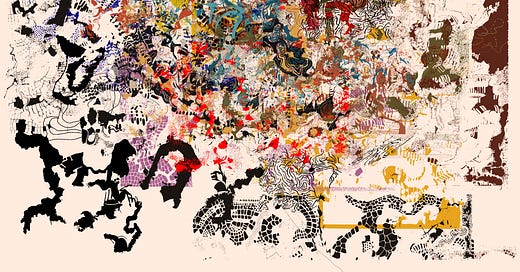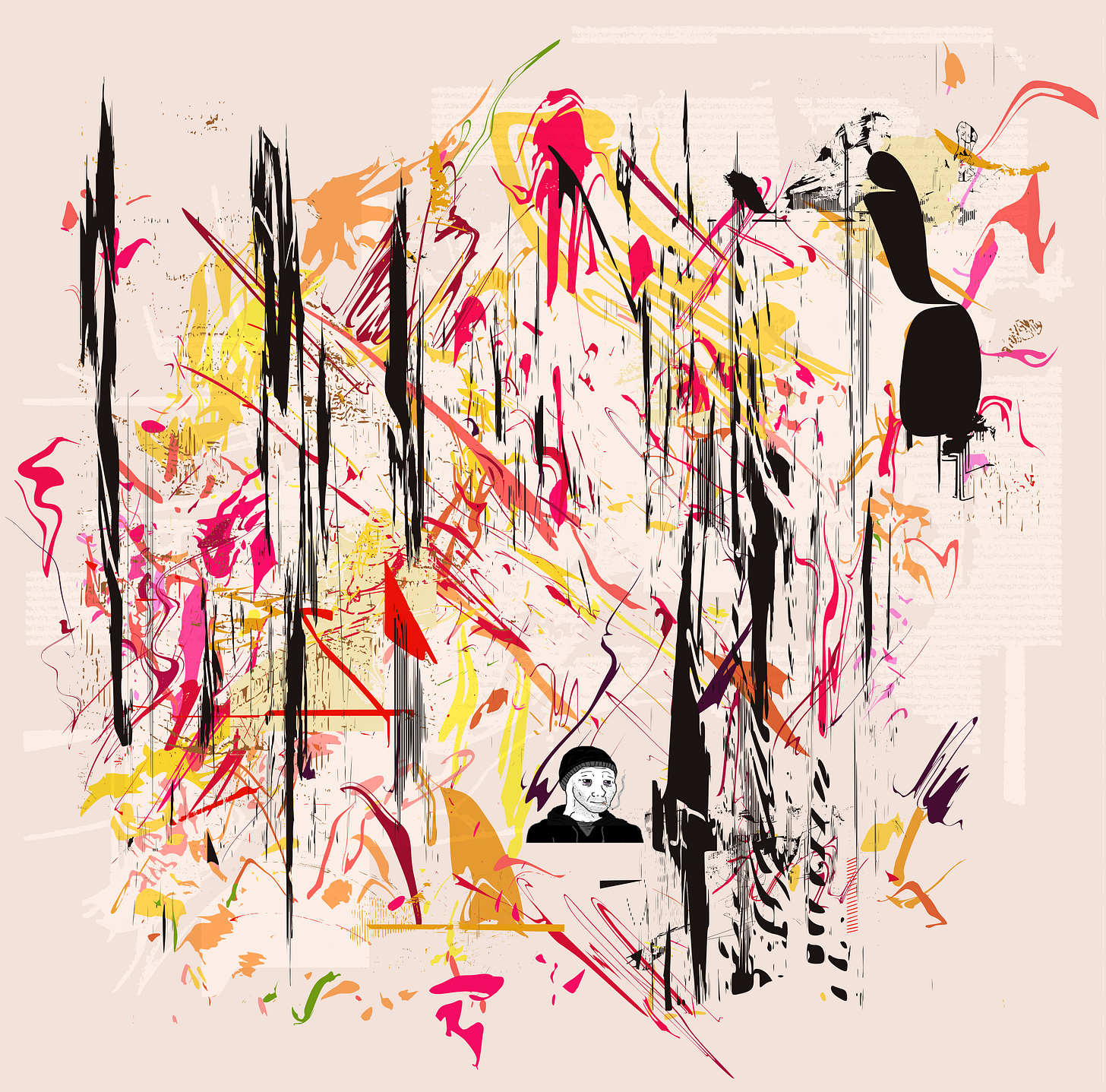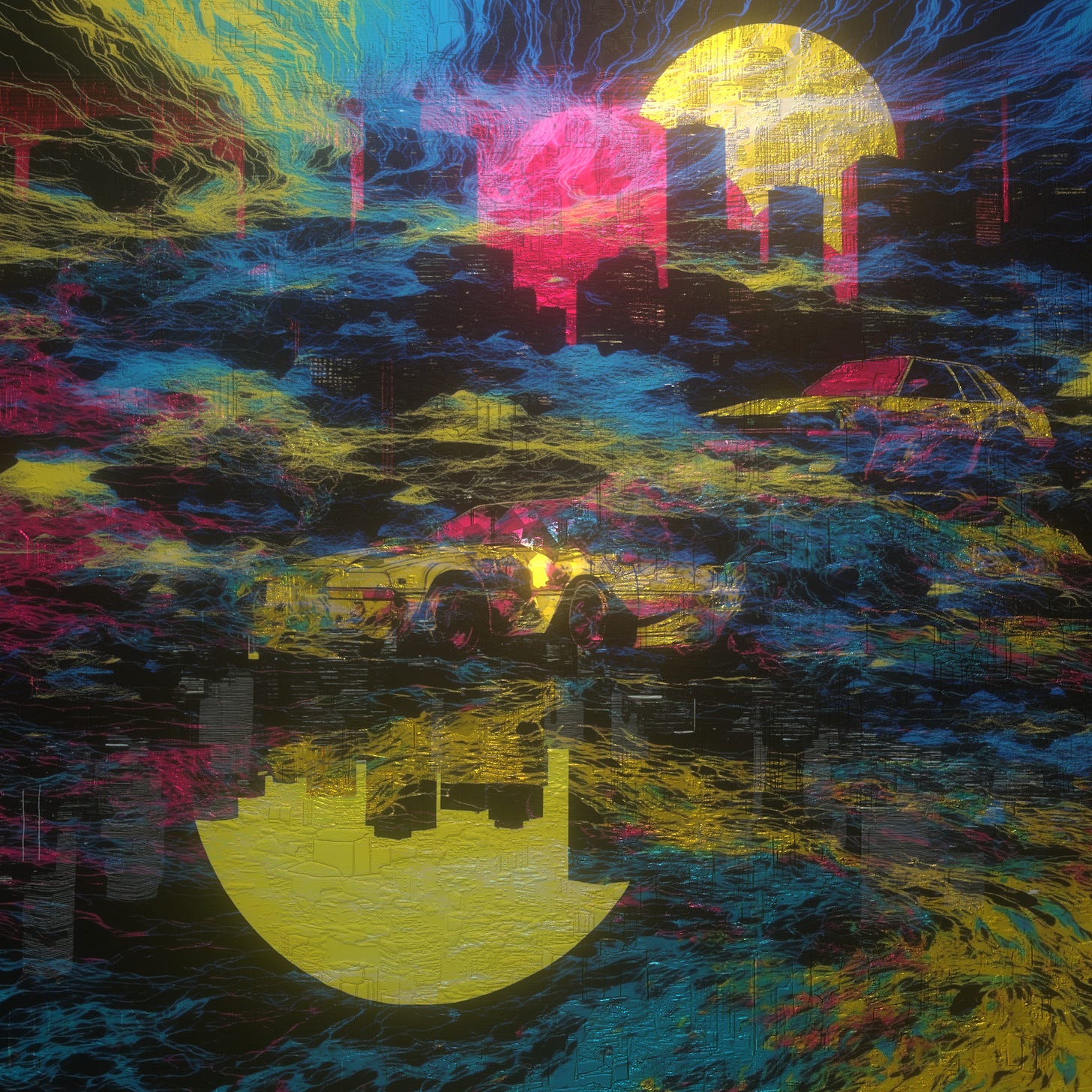“like the feeling of air existing even elsewhere” (image credit: Santiago)
1/1: Please introduce yourself.
Santiago: My name is Santiago. I’m an artist born in Montevideo, Uruguay, in 1986. I’ve been drawing and painting my whole life. I’m not known in the art system in my country. I was a poet for a while, and I published some poetry books in little zine-book type projects.
I make images using GIMP, Inkscape, Blender, text-to-image AI generators, and also hand-drawn inkwork and paintings, which I integrate into those digital pieces.
I’m very behind on books I want to read. I have them piled up, and I move piles from my room to my desk, occasionally reading a couple pages.
Recently, there's been a weird smell of slugs in my house because it has been raining for four days.
“happy afternoon if you incelebrate” (image credit: Santiago)
1/1: What art have you been working on lately?
Santiago: On some level, I think I’ve been ordering the thoughts reflected in those books. But more seriously, I’ve been making simple sculptures in Blender as well as collages. I have a pen plotter, which I had to build with Legos. For various reasons, it didn’t work out so great; however, I can use the machine in a limited sense and make drawings with it. I’m also using Midjourney to blend stuff together. And I make collages of those AI outputs and mix my physical and other digital work too.
1/1: Can you describe your workspace and how it influences your art?
Santiago: I have a desk in front of me right now, with my computer.
Next to me there’s a lamp for me to be able to draw. I have one of those carts that now has oil painting colors and liquids and some brushes on top. Where my feet are under the desk, there’re many plastic containers and some little piles of books on top of them.
I have a bookshelf here, one in my room, and another one in a little house behind this house. I’m trying super hard to keep my life in better order. I try to make little sticky notes with tasks, make food in advance and freeze it. I quit booze a year and a half ago—cigarettes last October. Although I’m not sure where this is going, as someone with a previously messy life in terms of timekeeping and health, I feel a sense of improvement.
“sides of the sea between ages of this bare second” (image credit: Santiago and RenderJuice)
All these practices of mine—to live healthier and more productively—I take as part of the work, and it impacts it. I’m somehow living a performance art piece about a visual artist who works on the internet and makes NFTs.
1/1: One of your bios says, “I make non-figurative images and try to approach art more as practice than ideas.” Can you elaborate on that?
Santiago: Yes, I make non-figurative images most of the time. I was trained as an abstract painter. I don’t care too much about the narrative side of images.
And about art as a practice, I guess I don’t love the ideal side of things, like trying to reflect or show an idea, which is kind of parallel to the efforts to make figuration, right?
I think of making, being present, being in the role of the artist, and as I said before, probably also as a performed role—a part I play or some kind of muscle memory or mental hygiene procedure.
“KUBBIO KUBO” (image credit: Santiago)
The job of a “painter” will always exist, but in our era, it probably has some kind of an outdated meaning. Everything ceases to make sense, being an artist, believing in “Art,” being a nice person. What does any of this even mean if we are unsure the air will be breathable in 15 years? It's sad, but I try to keep on believing (or acting as if I do?). I am a dad.
1/1: What tools do you use? Do you work with any special devices or tools unique to your creative process?
Santiago: I built this Lego plotter some days ago. It’s great. That’s one thing. I also make some little drawing tools using p5.js and ChatGTP. And I use those to draw. Limited, sometimes glitchy, always fun.
1/1: How do you approach developing an idea into a finished piece? Can you walk us through your workflow?
Santiago: Ok, so I start seeing what’s in my folders, and it’s always pieces of things I had been trying to understand, or little drawings, or unfinished fragments. Images, some from AI text-to-image sources, some from actually painting using GIMP, some from making vectors with images I made earlier or found in the directories later.
Other cases involve me photographing what I’m painting and starting some digital process with the photos. I’m always painting and drawing with ink, acrylics, oil, pencils, sharpies, etc. I take those and put them inside Inkscape, where I break them into vector shapes.
“morning walk in a made up memory” (image credit: Santiago)
Then, I compose with those vector shapes by moving them. After, I export the image to GIMP and pick them apart with a free-hand selection tool, change the hue of some sections, invert the colors in others, rotate little pieces, flip little pieces, cut and paste elsewhere in the composition, occasionally export a small image, send that to Inkscape to vectorize and break again, reshape, export once more, bring into Midjourney for the blend feature, paste some outputs together, collage them, occasionally print some to cut and paste with scissors and glue and draw on with pencils, pens, brushes, ink, and so on.
From time to time, I make some Blender sculptures and send an image render of them to vectorize and enter that other image-making machine. Many times, I’ve also minted those sculptures just as is.
1/1: Can you describe a typical day in your artistic practice, including any rituals or habits?
Santiago: I’m a dad, so a lot of my life aligns with this. If I can, I wake up late. Every day, I think the house should look better, but only on some days do I do anything about it. I have to say, my house looks pretty good, but anyway, it can always be better.
“this is not an industry” (image credit: Santiago)
I run to take Amalia to school most days. I come back home. I start thinking I should read more. Then I think I haven’t baked cookies or bread or lasagna or something else in a while, so I write that down. I have breakfast. I think I should sit down in front of the computer and draw. I put on music. I feel like I’m not reading enough, so I start drawing on the computer while thinking, “Hey, I should read more.”
Then it’s time to go pick up Amalia from school. Often, I then take her to her mom’s, so I’m back home after. I try to read. I take a shower. I eat more. I feel like I should watch some major movies I’ve never seen, so I check out the Criterion Channel and the mental list of things I should do grows. I go and buy more books online and my unread piles grow too.
And yet, somehow, between all this FOMO, I end up drawing, painting, and making art for five to ten hours daily.
“how do you feel about time” (image credit: Santiago)
1/1: How do you feel about the impact of generative AI on the creative process? Do you have a favorite AI tool?
Santiago: Currently, the blend feature in Midjourney is the thing I use the most. I think it’s the closest workflow to building one’s own model for those of us who remain front-end users of this AI art thing.
And out of everything I’ve used, my favorite would have to be EmProps. I was invited there to make a drop that came out in May 2023. It was amazing, and so much can happen there. Later, I made more projects with it that got to have some “universe of use”—a place, inside the tools, a place for me. It’s customizable random chunks of orders and prompts that’ll go to a blind mint later. It was very fun.
1/1: Are there any specific works of art (music, literature, film, etc.) that inspire or have significant meaning to you in your artistic practice?
“hologram card to bullish town” (image credit: Santiago)
Santiago: The internet as a collective, growing, immense work of art. And the movie “Synecdoche, New York” by Charlie Kaufman.
1/1: You’re probably the funniest NFT artist on Twitter. Do you ever think about integrating writing into your work more? I’m not sure what that would mean for an abstract painter, but the jokes seem to kill.
Santiago: Many of my works have very long titles. That’s how much I could integrate writing. I had stopped writing because it was too heavy for my head; images are better for me. I used to write poetry and experimental poetry and make visual poetry. But then it all became just visuals again.
Thanks for the compliment. I guess we become funny to escape pain? Not sure. You are very funny too, smart funny.
“i am this robot” (image credit: Santiago)
1/1: How do you come up with titles for your work?
Santiago: Just like I used to write poetry. I go to some place in my mind. It was built with a lot of work, rational and irrational operations, experiences lived, stuff read. And then it just became a territory where I go and naturally come up with some language artifacts. And those are the titles, which used to be the poems.
1/1: What draws you to NFTs and how do you see them as different from traditional art markets?
Santiago: It’s so much fun. And I couldn’t fit in the art world here. They didn’t like me too much. Maybe it’s my fault. We’ll never know. It’s a very sad part of me, how I don’t relate to that anymore. I really wanted to be included or at least for my work to be loved. Maybe later, one hopes, more internationally. I don’t know. Maybe NFTs become part of a bigger art thing.
1/1: What advice would you offer for someone just getting into NFTs?
“ask the future for a favor in the shape of a crystal giant bubble being born in the palm of the hand of every soldier of time against time” (image credit: Santiago)
Santiago: Make mistakes. Don’t follow rules. This place has only had a short life so far. What sometimes may appear as solid rules may only reflect some people’s agendas. Don’t pay too much attention.
1/1: Who are some of your favorite artists in the NFT space?
Santiago: Galina, littlecakes, Clint. All friends.
1/1: What are you working on next?
Santiago: I’m preparing a collective drop called “Wash Memetics.”
Analogous to when in wash trading and insider trading people have proprietary information, the drop includes friends who have common references and jokes, and we’ll make artwork referencing that universe.
“portrait of language” (image credit: Santiago)















Great read! A genuine legend 💖
this was a pleasure to answer
thanks so much <3